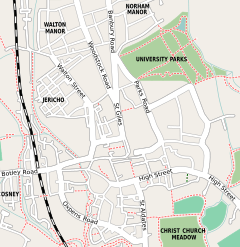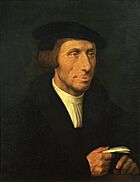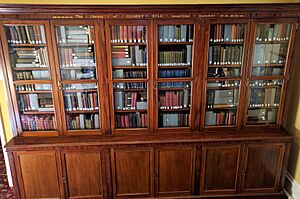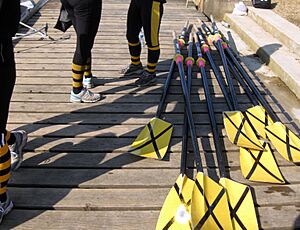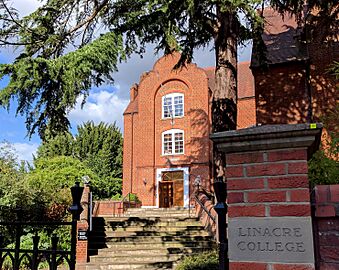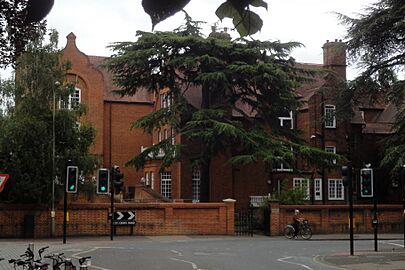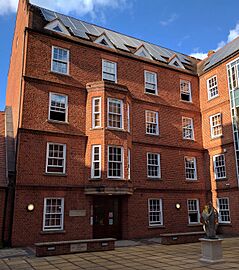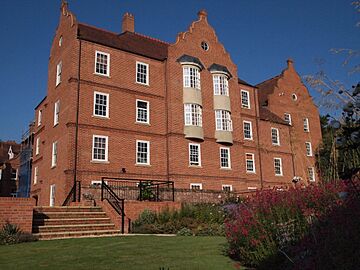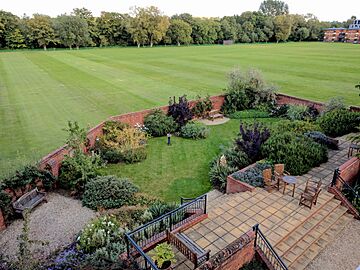Linacre College, Oxford facts for kids
Quick facts for kids Linacre College |
||||||||
|---|---|---|---|---|---|---|---|---|
 |
||||||||

Blazon: see below
|
||||||||
|
|
||||||||
| University | University of Oxford | |||||||
| Location | St Cross Road | |||||||
| Coordinates | 51°45′34″N 1°14′59″W / 51.75935°N 1.24984°W | |||||||
| Motto | No End To Learning | |||||||
| Established | 1962 | |||||||
| Named for | Thomas Linacre | |||||||
| Previous names | Linacre House (until 1965) | |||||||
| Sister college | Hughes Hall, Cambridge | |||||||
| Principal | Nick Brown | |||||||
| Undergraduates | None | |||||||
| Postgraduates | 550 | |||||||
| Grace | Benedictus benedicat | |||||||
| Boat club | Linacre College Boat Club | |||||||
| Map | ||||||||
Linacre College is a special part of the University of Oxford in the UK. It's a college just for students who are doing their postgraduate studies (like a master's degree or PhD). It has about 50 teachers and 550 postgraduate students.
Linacre is known for being very diverse. Most of its students come from outside the UK, representing 133 different countries! They also study many different subjects. Linacre was the first college in the UK for both boys and girls doing postgraduate studies in all subjects. Unlike most colleges, students and teachers share the same common room, which helps everyone feel more connected.
The college started in 1962. It is named after Thomas Linacre (1460–1524). He was a famous doctor who started the Royal College of Physicians. He was also a brilliant thinker during the Renaissance, interested in many different fields. The college tries to follow his example by encouraging students to explore many subjects.
You can find the college on St Cross Road. It's right next to University Parks and the university's science area.
Contents
History of Linacre College
Linacre College was first called Linacre House for its first three years. It was the UK's first college for postgraduate students of all genders and subjects. The first leader, John Bamborough, said it was an "experiment" to see if a new type of college could help postgraduate students.
It officially opened on August 1, 1962. It was in a building that used to belong to another college. At first, there were 115 members, and only 30 of them were British. Famous early members included Isaiah Berlin and Dorothy Hodgkin.
In November 1964, Linacre became a self-governing group. This meant it could make its own decisions. Then, on August 1, 1986, it became an independent college of Oxford University. This happened through a special document called a royal charter from the Queen. In 1977, Linacre moved to its current location. This building used to be a private home and a convent. Since 2010, the principal (the head of the college) has been Nick Brown.
Possible Name Change
In 2021, the college discussed a very large donation of £155 million from a group called SOVICO. If the college receives the first part of this money, it plans to ask for permission to change its name from Linacre College to Thao College. This donation would help create a new student center and provide scholarships. Some people at the university have raised questions about this proposed name change. In June 2022, the UK's Secretary of State for Education announced that there would be an official investigation into the agreement.
College Symbols: Coat of Arms and Motto
In 1988, Linacre College received its own coat of arms. This is a special design that represents the college. It shows an open book with the Greek letters Alpha and Omega. These are the first and last letters of the Greek alphabet. There are also three scallop shells around the book.
The college's motto, which is under the shield, is No End To Learning. This means that learning never truly stops. The college's colors are grey, yellow, and black.
The scallop shells and the Alpha and Omega symbols have special meanings. Scallop shells often represent a journey or pilgrimage. Alpha and Omega can mean completeness. So, together, they can show that studying is a complete journey of learning.
College Grace
The College Grace is a short prayer said in Latin at formal dinners. The Principal or a teacher says it.
Before the meal, everyone stands, and the words "Benedictus benedicat" are said. This means 'May the Blessed One give a blessing'. After the meal, everyone stands again, and the words "Benedicto benedicatur" are said. This means 'May the Blessed One be blessed'.
Buildings and Facilities at Linacre
Linacre's main campus is at the corner of South Parks Road and St Cross Road. The oldest building was built in 1886. It is now called the OC Tanner Building. There are also three newer buildings on the main site. These buildings are called the Bamborough, Abraham, and Griffiths buildings. They were finished in 1986, 1995, and 2008. These buildings provide 92 rooms for students on the main campus.
OC Tanner Building
The OC Tanner Building is the oldest part of the college. It holds most of the main facilities. All the staff offices and some student rooms are here. The heart of the building is a large common room. It has a bar and other fun things to do. The college library used to be a chapel. It has computers for students to use.
Gilbert Ryle Collection
Besides the main library, there is also a special collection of books. These books belonged to Gilbert Ryle. He was involved in starting Linacre House in 1962. When he retired, he gave many of his books to the college. The rest of his books were given after he passed away. These books are kept in a special bookcase in the library. Students can use them for their studies.
Bamborough Building
The Bamborough Building was the first big addition to the college. It opened in 1985. It is next to the OC Tanner Building. Together, they form a square area with a nice fountain. The Bamborough Building won an award in 1987 for its design.
Abraham Building
The Edward & Asbjörg Abraham Building was finished in 1995. It mainly has single bedrooms for students. This building was designed to be very environmentally friendly. It won the UK Green Building of the Year award in 1996. It also won other awards for being good for the environment. Solar panels were put on the roofs of the Abraham and Griffiths Buildings in 2011. The area between the Tanner, Abraham, and Griffiths buildings is called the Jaki Leverson Quad. It has a sculpture called 'The Dancing Phoenix'.
The Abraham Building's basement has a music practice room. It also has the college gym. The gym has rowing machines, weights, and other exercise equipment.
Griffiths Building
The Griffiths Building is the newest student residence on the main campus. It is named after Rodney Griffiths, a former student. It was finished in 2008. This building has 28 single rooms and 4 double rooms, all with their own bathrooms. They also have shared kitchens. It was nominated for two awards for its brick design.
Dining Hall
Linacre's large dining hall is between the OC Tanner and Abraham Buildings. It was added in 1977. It serves meals most weekdays for lunch and dinner.
The Rom Harré Garden
The Rom Harré Garden is the newest major addition to the college. It was finished in 2010. It is a quiet place with flowers and outdoor seating. Rom Harré is a former Vice-Principal and a respected teacher at the college.
Off-Site Accommodation
Linacre also owns or rents other buildings away from the main campus. These buildings provide another 102 rooms for students. This includes rooms for couples. The college usually offers a place to live for all new students. Many students move into private shared housing after their first year.
Student Life at Linacre
Common Room Activities
The college's social and sports activities are often organized by the Common Room. All students, teachers, and staff are members of this group. The Common Room has an elected committee. This committee plans events and works with college staff to help students.
The Common Room organizes many events during term time. A big highlight is the "bops." These are some of the largest student parties in Oxford. They happen on two floors and outside areas. Other college students can come to these themed parties. The biggest bop is usually for new students. Other social events include smaller parties, movie nights, cake baking, and cheese and wine tasting.
Clubs and Societies
Like all colleges, Linacre has many active sports teams. Students also play for the university in different sports. There are many clubs and societies, such as:
- Linacre Music Society
- Linacre College Boat Club (for rowing)
- Linacre Recreational Football Society
- Linacre Ladies that Lift (weightlifting)
- Linacre Yoga Society
- Linacre Green Society
- Linacre Intercultural Society
- Linacre Photo Society
Sustainability and Ethics
The college cares a lot about the environment. It is known as Oxford's "green" college. It has done many things to help the environment. Linacre has been ranked the greenest college by the student union many times. The Common Room has an environment officer. There is also an active green society and a gardening society. Linacre's Abraham building won the Green Building of the Year award in 1996.
In 2006, Linacre became the first carbon neutral college in Oxford. This means it balanced out its carbon emissions. In 2010, Linacre aimed to reduce its carbon emissions by 10% that year. It later set a goal to reduce them by 40% by 2020. Solar panels were put on the Abraham and Griffiths Buildings in 2011. In 2016, Linacre invested money in a renewable energy project. Linacre was also the first Oxford college to get "fairtrade" status in 2006. This means it supports fair trade practices.
Linacre hosts two main public lecture series each year:
Linacre Lectures on the Environment
For many years, the college has held annual Linacre Lectures. These talks are open to everyone. Since 1991, these lectures have focused on environmental challenges. Some past topics and speakers include:
- 2017: John Knox, "Global Threats to Environmental Human Rights Defenders".
- 2014: Michael Oppenheimer, on climate change and its impacts.
- 2013: Mike Gidney and others on "Food Security and Sustainability".
- 2012: Carl Folke and others on "Environmental Governance and Resilience".
- 2011: Lester R. Brown and others on "Riding the Perfect Storm".
Tanner Lectures on Human Values
The college also hosts the Tanner Lectures on Human Values. These lectures explore important ideas about human values. Some past topics and speakers include:
- 2019: Strobe Talbott, on leadership in difficult times.
- 2018: Abhijit Banerjee and Esther Duflo, on "Economics for the Human Race".
- 2017: George F. R. Ellis, on "On the Origin and Nature of Values".
- 2016: Shirley Williams, on "The Value of Europe and European Values".
- 2015: Peter Singer, on "From Moral Neutrality to Effective Altruism".
- 2014: Shami Chakrabarti, on "Human Rights as Human Values".
- 2013: Michael Ignatieff, on "Representation and Responsibility: Ethics and Public Office".
Notable Members of Linacre College
Alumni
- Yasmin Alibhai-Brown, journalist
- Carolyn Browne, diplomat and ambassador
- Stefan Buczacki, botanist and broadcaster
- Deborah Cadbury, author and TV producer
- Nigel A. L. Clarke, Minister of Finance for Jamaica
- Heather Couper, astronomer and TV presenter
- Neil Ferguson, epidemiologist
- Raymond Flood, mathematician
- Frene Ginwala, South African politician
- Joanna Kavenna, novelist and writer
- David Kelly, biological weapons expert
- Lady Gabriella Kingston, anthropologist and journalist
- Alister McGrath, professor of science and religion
- Urjit Patel, former Governor of the Reserve Bank of India
- Jake Wetzel, Olympic gold medallist rower
Fellows
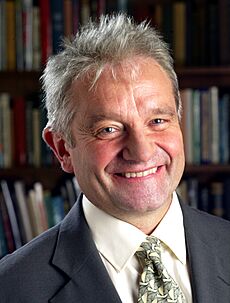
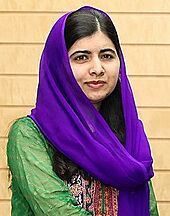
- Silke Ackermann, Director of the History of Science Museum
- Martin Aitken, professor of archaeometry
- Chris Dobson, chemist and structural biologist
- Ursula Dronke, expert in Old Norse
- Terry Eagleton, literary critic
- Margaret Gowing, historian of science
- Rom Harré, philosopher
- Sir John Hicks, Nobel Prize winner in Economics
- Schuyler Jones, anthropologist
- Sir Paul Nurse, Nobel Prize-winning biochemist
- Michael J. Whelan, professor of materials science
Honorary Fellows
- David Hope, Baron Hope of Thornes
- Malala Yousafazai, Nobel Peace Prize winner and education advocate
- Obert C. Tanner
- Geoffrey Thomas
Principals
- 1962–1988: John Bamborough, the first principal
- 1988–1996: Sir Bryan Cartledge
- 1996–2010: Paul Slack
- 2010–present: Nick Brown
Gallery


